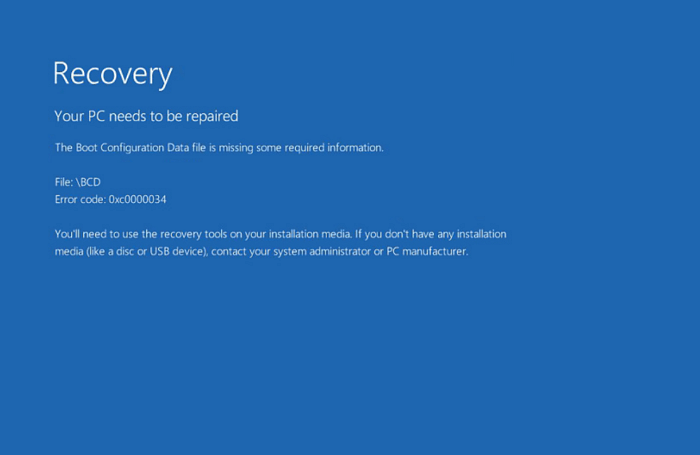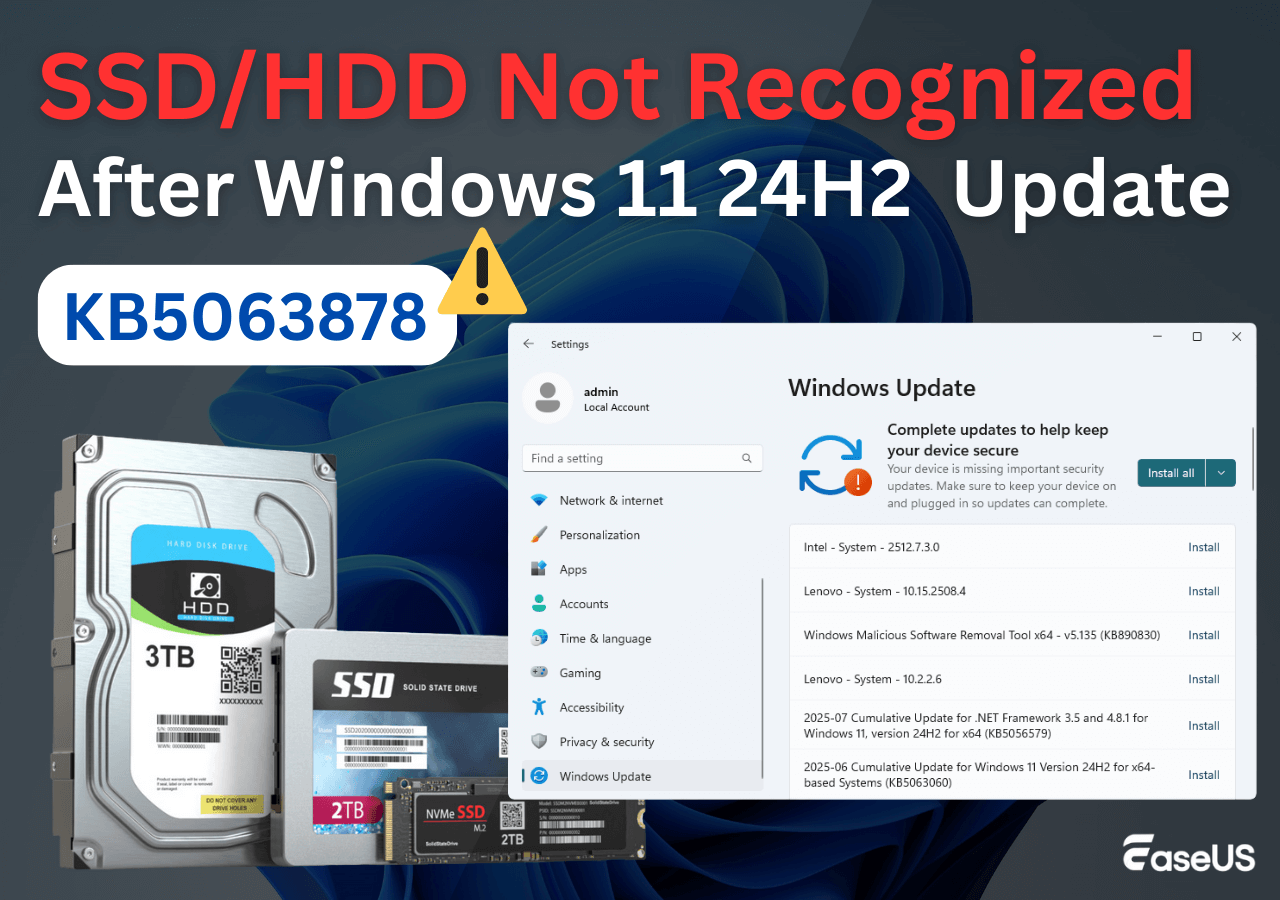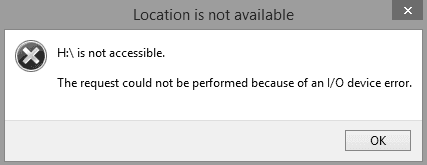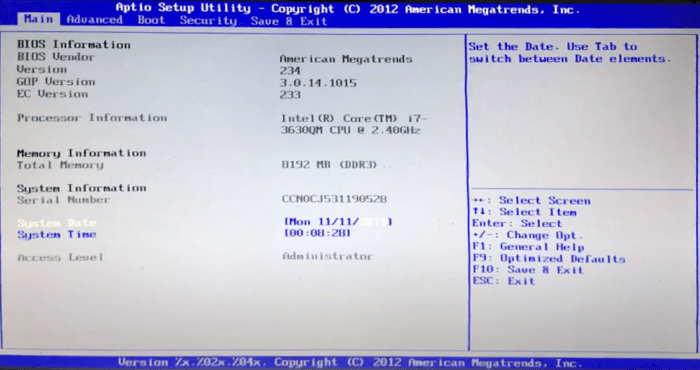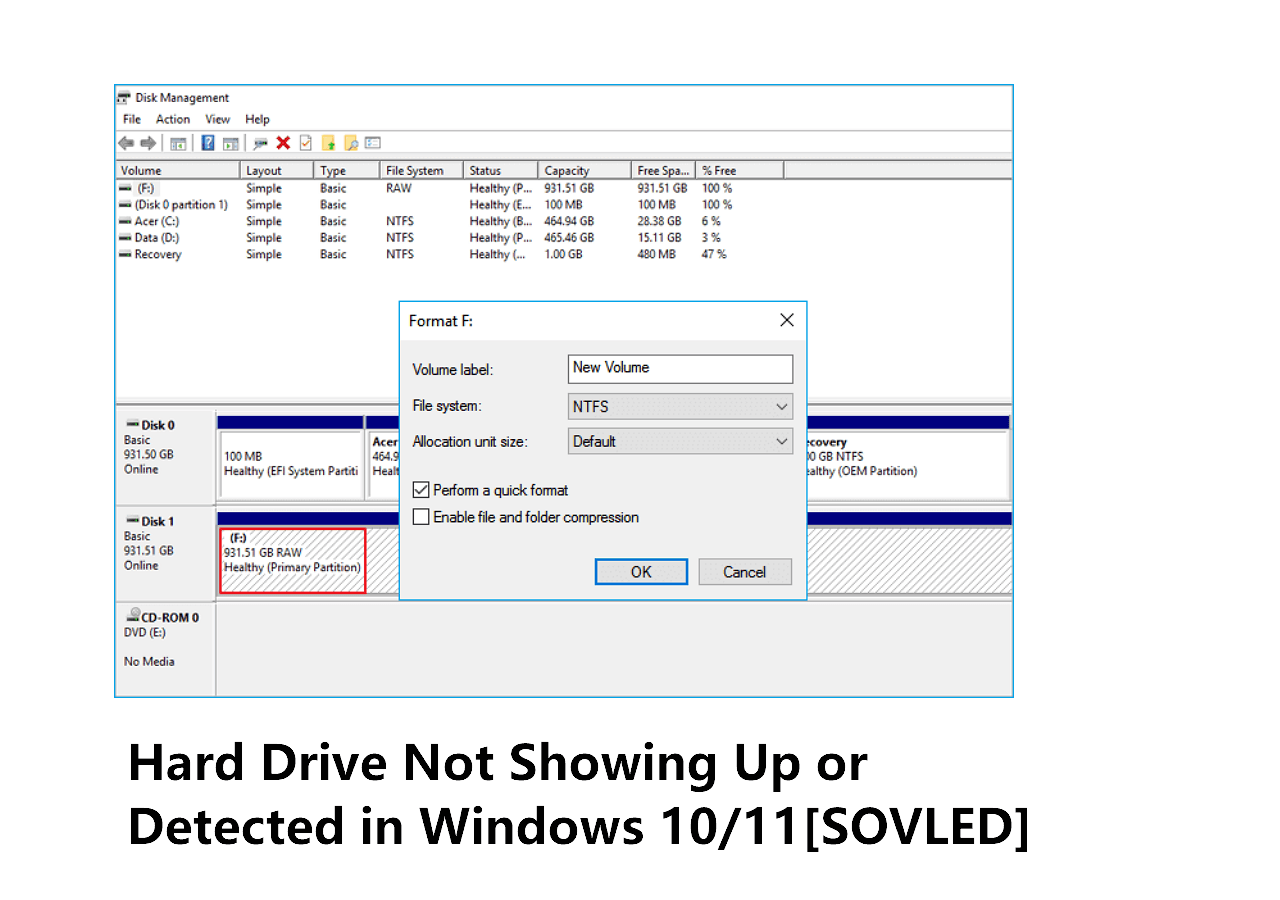-
![]() The Boot Configuration Data for Your PC Is Missing
The Boot Configuration Data for Your PC Is Missing December 12,2025
December 12,2025 6 min read
6 min read -
![]() [KB5063878] SSD/HDD Not Recognized After Windows 11 Update
[KB5063878] SSD/HDD Not Recognized After Windows 11 Update December 12,2025
December 12,2025 6 min read
6 min read -
![]()
-
![]() Fix Error 0x80070490 in Windows Update, Mail App, and Xbox [Full Guide in 2025]
Fix Error 0x80070490 in Windows Update, Mail App, and Xbox [Full Guide in 2025] December 12,2025
December 12,2025 6 min read
6 min read -
![]() Windows 11 Search Bar Not Working [Ultimate Guide]
Windows 11 Search Bar Not Working [Ultimate Guide] December 12,2025
December 12,2025 6 min read
6 min read -
![]() Fix Can't Be Performed Because of an I/O Device Error
Fix Can't Be Performed Because of an I/O Device Error December 12,2025
December 12,2025 6 min read
6 min read -
![]() How to Fix Memory Card Locked Error Without Losing Data
How to Fix Memory Card Locked Error Without Losing Data December 12,2025
December 12,2025 6 min read
6 min read -
![]() Aptio Setup Utility Ultimate Guide | How to Access/Fix It
Aptio Setup Utility Ultimate Guide | How to Access/Fix It December 14,2025
December 14,2025 6 min read
6 min read -
![]() My GhostWire: Tokyo Save File Lost! How to Recover
My GhostWire: Tokyo Save File Lost! How to Recover December 12,2025
December 12,2025 6 min read
6 min read -
![]() Hard Drive Not Showing Up or Detected in Windows (Fixed)
Hard Drive Not Showing Up or Detected in Windows (Fixed) December 12,2025
December 12,2025 6 min read
6 min read
Page Table of Contents
PAGE CONTENT:
- Fix 1. Solve Specified File Path Not Found Error with Recovery Software
- Fix 2. Fix the System Cannot Find The Path Specified by Deleting Invalid Paths
- Fix 3. Check the System Registry to Solve the Path Not Found Error
- Fix 4. Run an SFC Scan to Solve the System File Searching Error Quickly
- More Solutions to Solve System Cannot Find The Path Specified
Have you taken an invalid route while saving or downloading? You may encounter "The system cannot find the path specified" on your Windows PC. This error may also ensue if a directory has been altered erased or damaged system files are present. Such a message emphasizes the intricacy of your device and its demand for a harmonizing amalgamation of consistency and burstiness in solutions.
This error might occur due to common mistakes, such as typing the wrong path on the Command Prompt or a program installation negligence. Hence, if you face this error, never take it casually!
Knowing the root cause of this error is crucial for troubleshooting; we will discuss the top fix
Fix 1. Solve Specified File Path Not Found Error with Recovery Software
If you have encountered this error, you may use the EaseUS Data Recovery Wizard to retrieve the missing files. You can click the following download button to get the free trial easily.
This tool stands out as reassuring in the kingdom of data recovery and can be very reliable in resolving files that suddenly disappeared from a hard drive. Customized to restore more than 2000 file types, it covers lost items; you can easily find missing Excel files, lost camera images, and deleted movies.
Opting for EaseUS Data Recovery Wizard ensures that this petrifying error can be eliminated by effectively retrieving the missing data. With this powerful recovery program, you can also fix issues like the missing Pictures folder in Windows 11.
Step 1. Select a location and start scanning
Launch EaseUS Data Recovery Wizard and choose the partition where you lost data. Then, click "Search for Lost Data".

Step 2. Filter and preview files
Use the file format filter on the left or upper right corner to find the files you need. If you remember the file name, you can also search in the search box, which is the fastest way to find the target file. Then, you can click the "Preview" button or double-click a file to preview its content.

Step 3. Recover lost data or files
Click the checkbox next to the file and click "Recover" to restore the lost data to your local storage or Cloud drive.

Download this professional data retrieval software today! If you found this passage helpful, kindly share the information with your friends on social media.
Fix 2. Fix the System Cannot Find The Path Specified by Deleting Invalid Paths
An environment variable consists of data that impacts how running procedures will act on your system. Therefore, if you run a program on your PC from the command line, the PATH ecosystem variables significantly save the directory path, which can be searched.
To understand how it works, imagine a PC with two distinct directories. If you're willing to operate a program in a distinct directory, your system will look for the directories recorded in the PATH variable. Your Windows PC may run it without any hassles if the program is available in any directories.
Nevertheless, if you provide an erroneous path variable, the entire process will go haywire, generating this error. Therefore, the excellent way to resolve this error is to delete invalid routes from the Environment Variable. Go through the steps below to delete invalid paths:
Step 1. Launch the File Explorer on your PC.
Step 2. Search for "This PC" path located on the left-side navigation. Now, right-click on it to opt for "Properties."

Step 3. Hit the "Advanced system settings" link in the new window.

Step 4. Hit the "Environment Variables" button from the "Advanced" tab on the "System Properties" window.
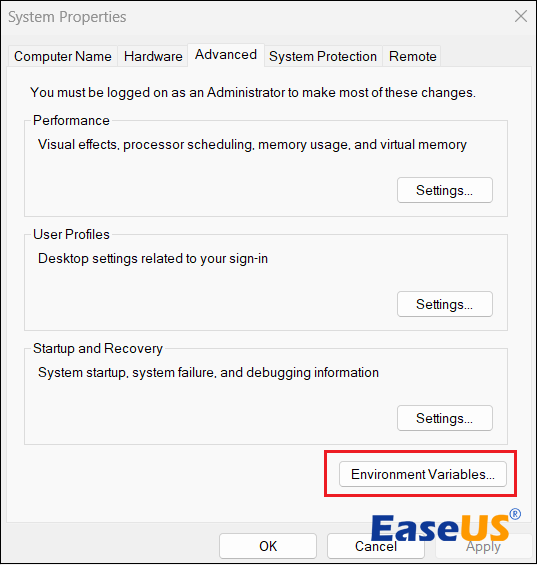
Step 5. Search for the "PATH" variable under the "User Variables" section by hitting the "Edit" button, which will demonstrate the user variables.

Step 6. You must verify if the paths are working correctly by copying the path and pasting it into File Explorer's address bar. This will let you know if the application can detect the path. In case it can't, the path must be incorrect! Therefore, you need to "Edit" or "Delete" it. Once done, hit the "OK" button.
Step 7. Hit the "PATH" variable underneath the "System Variables Section" and the "Edit" button.
Step 8. Repeat the steps mentioned above to verify if the paths are functioning properly.
Fix 3. Check the System Registry to Solve the Path Not Found Error
The reason for seeing this error is you might have edited the AutoRun keys in the Windows Registry Editor. Go through the steps below to check the system registry to solve this error:
Step 1. Press the "Win + R" keys to launch the Run box. Here, type "Regedit" and hit the "Enter" button.
Step 2. Copy and paste the path on the registry editor: HKEY_LOCAL_MACHINE\Software\Microsoft\Command Processor
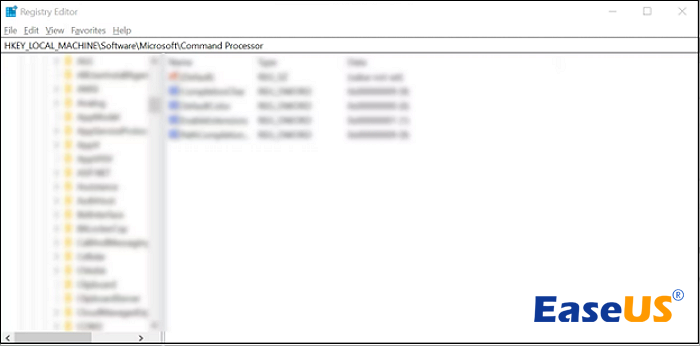
Step 3. Search for an "AutoRun" key. In case you have found the key, it's time to "Modify" or "Delete" the data.

You can share this method on social media to help more users solve the path not found error.
Fix 4. Run an SFC Scan to Solve the System File Searching Error Quickly
If the error is generated by missing or corrupted system files, you may use the SFC Windows repair tool to resolve "The System File Searching Error" quickly. You can also apply this command to fix the system cannot find the file specified.
These are the steps to follow:
Step 1. Press "Win + R" together to launch "Run." After that, type cmd and hit the "Enter" button.
Step 2. Type sfc /scannow on the Command Prompt, and hit "Enter."

Step 3. In case SFC detects errors but can't mend them, type the command after exe /Online /Cleanup-image /Scanhealth and hit the "Enter" button.
Step 4. Type exe /Online /Cleanup-image /Restorehealth, and hit the "Enter" button.
Step 5. Restart your PC, and check if it resolves the issue.
Fix 5. Recheck that the Files & Folders are Downloaded Completely
In case you've installed or downloaded an application or program recently, you should check that the entire file is present. An incomplete download of the files that aren't correctly installed won't launch through Command Prompt.
Hence, you need to move to the location of the file Command Prompt can't access and notice if it was precisely installed. In case a file was downloaded or installed appropriately, rechecking the files and folders is essential as it will resolve the issue.

Fix 6. Update Windows OS to Troubleshoot the System Cannot Find The Path Specified
If you haven't updated your Windows OS, it may bring forth some errors in system folders, contributing to its inaccessibility. Hence, completing a pending update is one of the best ways to address this. Go through the steps below to update Windows OS to troubleshoot the system without the specified path:
Step 1. Navigate to "Settings"> "Windows Update," and hit "Check for updates."

Step 2. Install every essential and growing update for your Windows PC.
If the methods mentioned in this passage work, please share them with your friends now!
Conclusion
The complexity of today's technologies is reflected in the maze-like digital difficulties where errors such as "the system cannot find the path specified" frequently block our advancement. It's critical to identify the cause of failures, whether you're having trouble with Windows 10, Java pathing, or adjusting to the unfamiliar landscape of Windows 11.
You may reinstate order in the digital realm by employing one of the plenty of accessible options, which range from checking file directories to applying sophisticated data retrieval programs like EaseUS Data Recovery Wizard. Difficulties associated with technology change with time, but they can all be resolved if you have the appropriate information and resources at your fingertips.
Specified Paths Cannot be Found in the System FAQs
These are the FAQs to consider:
1. What causes the error "The system cannot find the path specified" in Windows 10?
The system additionally displays the "specified path not found" notification to indicate that it cannot identify the provided file or location. This could happen if the file is deleted, the USB is unplugged, a network path has been obstructed, or there are registry conflicts with the computer.
2. How do we fix the system that cannot find the path with CMD?
You must launch Command Prompt as an administrator with "Ctrl + R" and then press "Ctrl + Shift + Enter." In the next step, you have to type the command sfc/scannow, and hit "Enter," which will start the SFC tool that helps scan the system files.
3. What is the correct command to find specific files in Windows?
You may look for files, display their directories using the "dir" command, and enter a search query. Use the "cd" command to access a file by navigating to its directory, then type the file name into Command Prompt. Place enclosed quotation marks around any blanks in the URL or filename.
Was this page helpful?
-
Dany is an editor of EaseUS who lives and works in Chengdu, China. She focuses on writing articles about data recovery on Mac devices and PCs. She is devoted to improving her writing skills and enriching her professional knowledge. Dany also enjoys reading detective novels in her spare time. …

20+
Years of experience

160+
Countries and regions

72 Million+
Downloads

4.9 +
Trustpilot Score


Free Data
Recovery Software
Recover data up to 2GB for free!
